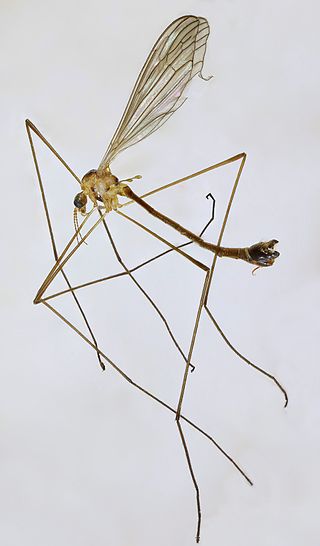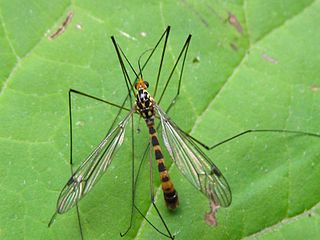
A crane fly is any member of the dipteran superfamily Tipuloidea, which contains the living families Cylindrotomidae, Limoniidae, Pediciidae and Tipulidae, as well as several extinct families. "Winter crane flies", members of the family Trichoceridae, are sufficiently different from the typical crane flies of Tipuloidea to be excluded from the superfamily Tipuloidea, and are placed as their sister group within Tipulomorpha.

Tipulidae is a family of large crane flies in the order Diptera. There are more than 30 genera and 4,200 described species in Tipulidae, common and widespread throughout the world.

The Tipulomorpha are an infraorder of Nematocera, containing the crane flies, a very large group, and allied families.

The Nematocera are a suborder of elongated flies with thin, segmented antennae and mostly aquatic larvae. This group is paraphyletic and contains all flies but species from suborder Brachycera, which includes more commonly known species such as the housefly or the common fruit fly. The equivalent clade to Nematocera is the whole Diptera, with Brachycera as a subclade. Families in Nematocera include mosquitoes, crane flies, gnats, black flies, and multiple families commonly known as midges. The Nematocera typically have fairly long, fine, finely-jointed antennae. In many species, such as most mosquitoes, the female antennae are more or less threadlike, but the males have spectacularly plumose antennae.

Carl Robert Osten-Sacken or Carl-Robert Romanovich, Baron von der Osten-Sacken, Baron Osten Sacken was a German-Russian diplomat and entomologist. He served as the Russian consul general in New York City during the American Civil War, living in the United States from 1856 to 1877. He worked on the taxonomy of flies in general and particularly of the family Tipulidae.

Trichoceridae, or winter crane flies, of the order Diptera are long, thin, delicate insects superficially similar in appearance to the Tipulidae, Tanyderidae, and Ptychopteridae. The presence of ocelli distinguishes the Trichoceridae from these other families. There are approximately 160 known species. The adults can be found flying in the fall and the spring and some are active even in the winter, hence their common name. They form dancing, loose swarms of mostly males. Adults can also be found resting inside caves and hollow logs. Larvae occur in moist habitats where they feed on decaying organic matter. They are of no economic importance.

Limoniidae is the largest of four crane fly families, with more than 10,700 species in more than 150 genera. Some studies have suggested it to be a paraphyletic group, with some limoniids being more closely related to Tipulidae and Cylindrotomidae than to other limoniids. Limoniid crane flies can usually be distinguished by the way the wings are held at rest. Limoniids usually hold/fold the wings along the back of the body, whereas other crane flies usually hold them out at right angles. Snow flies such as Chionea scita have no wings at all. Limoniids are also usually smaller than other crane flies, with some exceptions.
Charles Paul Alexander was an American entomologist who specialized in the Tipulidae family of craneflies.

Tipula is a very large insect genus in the fly family Tipulidae. The members of this genus are sometimes collectively called common crane flies. Tipula contains over 2,000 species located throughout the world.
Neocladura is a genus of crane fly in the family Limoniidae.

The Pediciidae or hairy-eyed craneflies are a family of flies closely related to true crane flies, with about 500 species worldwide.

Tipula fulvipennis is a species of true crane flies in the family Tipulidae.

The Cylindrotomidae or long-bodied craneflies are a family of crane flies. More than 65 extant species in 9 genera occur worldwide. There are more than 20 extinct species.

Diogma is a genus of crane flies in the family Cylindrotomidae.
Stibadocerina is a genus of crane fly in the family Cylindrotomidae.
The Stibadocerinae are one of two subfamilies in the crane fly family Cylindrotomidae. Stibadocerinae has a total of 20 recorded species, found only in the southern hemisphere.

Tipulinae is a subfamily of crane flies. It contains the typical crane flies from the genus Tipula.

Limonia nubeculosa, also known as the short-palped cranefly, is a species of crane flies in the family of Limoniidae.

Nephrotoma flavipalpis is a species of crane flies in the family Tipulidae.

Tipula abdominalis, the giant crane fly, is a species of large crane flies in the family Tipulidae.














